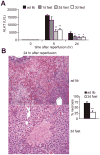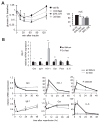Short-term dietary restriction and fasting precondition against ischemia reperfusion injury in mice
- PMID: 19878145
- PMCID: PMC3412229
- DOI: 10.1111/j.1474-9726.2009.00532.x
Short-term dietary restriction and fasting precondition against ischemia reperfusion injury in mice
Abstract
Dietary restriction (DR) extends lifespan and increases resistance to multiple forms of stress, including ischemia reperfusion injury to the brain and heart in rodents. While maximal effects on lifespan require long-term restriction, the kinetics of onset of benefits against acute stress is not known. Here, we show that 2-4 weeks of 30% DR improved survival and kidney function following renal ischemia reperfusion injury in mice. Brief periods of water-only fasting were similarly effective at protecting against ischemic damage. Significant protection occurred within 1 day, persisted for several days beyond the fasting period and extended to another organ, the liver. Protection by both short-term DR and fasting correlated with improved insulin sensitivity, increased expression of markers of antioxidant defense and reduced expression of markers of inflammation and insulin/insulin-like growth factor-1 signaling. Unbiased transcriptional profiling of kidneys from mice subject to short-term DR or fasting revealed a significant enrichment of signature genes of long-term DR. These data demonstrate that brief periods of reduced food intake, including short-term daily restriction and fasting, can increase resistance to ischemia reperfusion injury in rodents and suggest a rapid onset of benefits of DR in mammals.
Figures






Similar articles
-
Effects of timing of food intake and fat/carbohydrate ratio on insulin sensitivity and preconditioning against renal ischemia reperfusion injury by calorie restriction.Nutr Healthy Aging. 2019 Apr 2;5(1):23-32. doi: 10.3233/NHA-180044. Nutr Healthy Aging. 2019. PMID: 31093582 Free PMC article.
-
Mannan-Binding Lectin Is Involved in the Protection against Renal Ischemia/Reperfusion Injury by Dietary Restriction.PLoS One. 2015 Sep 14;10(9):e0137795. doi: 10.1371/journal.pone.0137795. eCollection 2015. PLoS One. 2015. PMID: 26367533 Free PMC article.
-
A signature of renal stress resistance induced by short-term dietary restriction, fasting, and protein restriction.Sci Rep. 2017 Jan 19;7:40901. doi: 10.1038/srep40901. Sci Rep. 2017. PMID: 28102354 Free PMC article.
-
Benefits of short-term dietary restriction in mammals.Exp Gerontol. 2013 Oct;48(10):1043-8. doi: 10.1016/j.exger.2013.01.009. Epub 2013 Feb 1. Exp Gerontol. 2013. PMID: 23376627 Free PMC article. Review.
-
Is Overnight Fasting before Surgery Too Much or Not Enough? How Basic Aging Research Can Guide Preoperative Nutritional Recommendations to Improve Surgical Outcomes: A Mini-Review.Gerontology. 2017;63(3):228-237. doi: 10.1159/000453109. Epub 2017 Jan 5. Gerontology. 2017. PMID: 28052287 Free PMC article. Review.
Cited by
-
Interactions between oxygen homeostasis, food availability, and hydrogen sulfide signaling.Front Genet. 2012 Nov 27;3:257. doi: 10.3389/fgene.2012.00257. eCollection 2012. Front Genet. 2012. PMID: 23233860 Free PMC article.
-
Short-term calorie and protein restriction provide partial protection from chemotoxicity but do not delay glioma progression.Exp Gerontol. 2013 Oct;48(10):1120-8. doi: 10.1016/j.exger.2013.02.016. Epub 2013 Feb 21. Exp Gerontol. 2013. PMID: 23454633 Free PMC article.
-
Effects of timing of food intake and fat/carbohydrate ratio on insulin sensitivity and preconditioning against renal ischemia reperfusion injury by calorie restriction.Nutr Healthy Aging. 2019 Apr 2;5(1):23-32. doi: 10.3233/NHA-180044. Nutr Healthy Aging. 2019. PMID: 31093582 Free PMC article.
-
Whole-transcriptome analysis of mouse adipose tissue in response to short-term caloric restriction.Mol Genet Genomics. 2016 Apr;291(2):831-47. doi: 10.1007/s00438-015-1150-3. Epub 2015 Nov 25. Mol Genet Genomics. 2016. PMID: 26606930
-
Mannan-Binding Lectin Is Involved in the Protection against Renal Ischemia/Reperfusion Injury by Dietary Restriction.PLoS One. 2015 Sep 14;10(9):e0137795. doi: 10.1371/journal.pone.0137795. eCollection 2015. PLoS One. 2015. PMID: 26367533 Free PMC article.
References
-
- Ahmet I, Wan R, Mattson MP, Lakatta EG, Talan M. Cardioprotection by intermittent fasting in rats. Circulation. 2005;112:3115–21. - PubMed
-
- Bishop NA, Guarente L. Genetic links between diet and lifespan: shared mechanisms from yeast to humans. Nat Rev Genet. 2007;8:835–44. - PubMed
-
- Chandrasekar B, Nelson JF, Colston JT, Freeman GL. Calorie restriction attenuates inflammatory responses to myocardial ischemia-reperfusion injury. Am J Physiol Heart Circ Physiol. 2001;280:H2094–102. - PubMed
Publication types
MeSH terms
Substances
Grants and funding
LinkOut - more resources
Full Text Sources
Other Literature Sources
Medical

